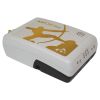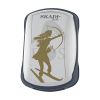Eos Arrow 200 RTK GNSS Receiver
The Eos Arrow 200 is a GNSS receiver capable of providing 1cm real-time accuracy on any Android, iOS and Windows mobile device.
Features
- Supports existing and future GNSS (GPS, GLONASS, Galileo, BeiDou)
- 100% Android, iOS, Windows compatible
- 1cm RTK real-time accuracy
- Free ground shipping
- Expedited repair and warranty service
- Lifetime technical support
- More
The World’s First RTK Receiver for Every Mobile Device
Designed for use with a broad range of mobile devices, from smartphones to tablets and notebook computers, the Eos Arrow 200 incorporates rock-solid, wireless Bluetooth technology that works smoothly with Android, iOS, and Windows devices, making it obsolete-proof and portable across platforms.
Consumer Choice of Mobile GIS Software
The Arrow 200 feeds 1cm RTK accuracy to every app on Android or iOS devices, including Google or Apple maps. The Arrow 200 works seamlessly with Esri Collector/ArcPad/ArcMobile, Fulcrum, AmigoCloud, TerraFlex, MapItFast, GeoJot, iCMTGIS and many more mapping apps.
All Satellites, All Signals
The Eos Arrow 200 incorporates premium features that place it among the highest-performing receivers in the world. It takes advantage of all existing satellite constellations (GPS, GLONASS, BeiDou, SBAS) as well as emerging and planned constellations (Galileo and QZSS) to deliver top-notch, 1cm RTK performance anywhere in the world when connected to an RTK Network or 10-15cm accuracy using OmniSTAR HP or G2.
The Ultimate in Worldwide High-Precision GNSS Technology
The Arrow 200 provides ultimate flexibility. Use one of OmniSTAR’s services to get 10cm real-time accuracy anywhere in the world. Collect data anywhere in the world using Eos’ free data collection program and post-process the data using free online processing services like PUS or AUSPOS to achieve centimeter accuracy anywhere.
- (1) Arrow 200 receiver with Arrow Smart Battery Pack
- (1) Dual-Frequency GNSS / LBand Precision Antenna
- (1) Large Antenna Mounting Plate
- (1) Two-section Short Antenna Cable for survey pole
- (1) Arrow Pole Mount Bracket
- (1) Range Pole Clamp
- (1) USB Data Cable
- (1) 12V International Power Supply for Arrow Smart Battery pack
- (1) Hard Shell Case
In The News
Eos Arrow receivers give GIS pros real-time data, solid connectability
For pros working in mapping, surveying and other GIS fields, quick, precise data are a must. And the key to getting those data is getting the right receiver. As a result, many turn to high-accuracy, multi-constellation receivers like the Arrow series built by Eos Positioning Systems. The series includes the Eos Arrow Lite GPS Receiver, Eos Arrow 100 GNSS Receiver and Eos Arrow 200 L1/L2 GNSS Receiver. The receivers are popular for many reasons: They have the flexibility to use multiple satellite constellations, offer real-time data transmission capability and can connect to any device via Bluetooth. The Arrow receivers use the United States’ GPS constellation of satellites, but they can just as easily link up with Russia’s GLONASS, China’s Beidou and Europe’s Galileo.
Read MoreSource Water Monitoring in Albany, New York: Tracing Water Quality throughout Tributaries
Thousands of US cities pull their drinking water from natural source waters like reservoirs, rivers, and streams, making overall watershed health a key consideration for water providers. In Albany, New York, the Albany Department of Water and Water Supply delivers drinking water to over 100,000 residents as well as monitors and manages the larger drinking water supply watershed. Hannah Doherty, Environmental Specialist at the Albany Department of Water and Water Supply , spends her days working with a small team to monitor the drinking supply and the connected water bodies. Doherty explains, “We’re the first to encounter the water that ends up being the drinking water.
Read MoreWildfire Prevention in the Sierra Nevada Region with the Yuba Watershed Institute
Though recent wildfires have sparked new conversations about wildfire management and response, groups like the Yuba Watershed Institute have been monitoring the forests and water resources of the Sierra Nevada region for decades, managing approximately 5,000 acres of land with the Bureau of Land Management (BLM) and about 7,000 acres in private land partnerships. The goal of the Institute is to work with local communities and land agencies to improve watershed and forestry management through informed practices and public outreach. The goals of the Yuba Watershed Institute are three-fold: Improve the ability of fire suppression agencies like the California Department of Forestry and Fire Protection ( CAL FIRE ) and the US Forest Service.
Read More







































